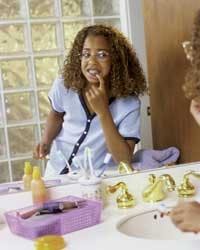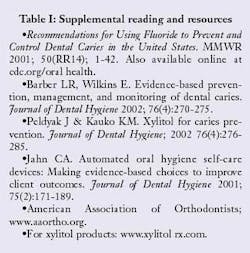New Article
by Carol Jahn, RDH, MS
Remember what it was like to wear orthodontic appliances 30 years ago? You didn't want to get them but your parents made you. You had to have teeth extracted; probably some of your bicuspids. The cute classmate who sat next to you called you tinsel teeth. You were scared to kiss someone else with orthodontics because your braces may lock together! The hard toothbrush you had was difficult to manipulate around the brackets and wires. You were excited when the braces came off and horrified by all the white spots and fillings you needed afterward.
Today, having orthodontic treatment is easier than ever. So easy, in fact, that about 20 percent of orthodontic patients are adults. Braces are now smaller and more efficient. Brackets may be clear or even colored depending on preference. The American Academy of Orthodontists reports that a clear orthodontic wire is in an experimental stage.
Regardless of age, keeping teeth and gingiva healthy during treatment is a top priority. Fortunately, advances in fluoride delivery systems and innovative self-care products can assist almost any patient in having optimal oral health while in orthodontic treatment. Just as important, helping patients keep their teeth and gingiva healthy during treatment can enhance self-esteem and make orthodontic care a more pleasant experience.
Preventing decay
According to the report called Recommendations for Using Fluorides to Prevent and Control Dental Caries in the US, by the Centers for Disease Control, there are specific population groups that are more at-risk for dental caries. One group cited as high-risk for caries is individuals who wear space maintainers and orthodontic appliances. Other risk factors, which may be relevant for orthodontic patients, include having a personal or family history of caries and poor oral hygiene. Adult orthodontic patients may sometimes have exposed root surfaces and/or reduced salivary flow, which can also play a role in the risk for decay.
Fluorides — The first line of defense for preventing decay is adequate exposure to fluoride. Due to the high-risk status of orthodontic patients, fluoride from drinking water and toothpaste may not be enough. Therefore, additional fluoride exposure is recommended. At minimum, most orthodontic patients can benefit from an over-the-counter daily 0.05% (223 ppm) sodium fluoride rinse and professionally applied fluoride treatments at each recare visit. Professionally applied treatments may include acidulated phosphate fluoride (1.23%, 12,300 ppm), sodium fluoride (0.9%, 9,040 ppm), or a fluoride varnish. For adults with glass ionomer, porcelain, or composite restorations, neutral sodium fluoride may be preferred as the low pH solution of APF can degrade these materials.
Fluoride varnish is a relatively new delivery mechanism in the United States, although it has been widely used in Canada and Europe since the 1970s. Varnish is available in both sodium fluoride (2.26%, 2,600 ppm) or difluorsilane (0.1%, 1,000 ppm) formulations. With a varnish, the fluoride is painted directly onto teeth, keeping a high level of fluoride in close contact with the teeth for several hours. Currently, the FDA has not approved fluoride varnishes as an anticaries agent, although off-label use is allowed based on professional judgment. One European study found that a fluoride varnish prevents decalcification beneath orthodontic bands.
For orthodontic patients with multiple risk factors or a past history of caries, a self-applied gel (at-home) of either sodium (0.5% 5,000 ppm) or stannous (0.15%, 1000 ppm) fluoride may be better than a 0.05% over-the-counter sodium fluoride rinse. New research also indicates that even individuals with poor oral hygiene may still benefit from fluoride. While it was once believed that a plaque-free tooth surface was needed for optimal fluoride uptake, it has now been shown that when fluoride is present in the mouth, it is retained and concentrated in plaque.
Xylitol — Xylitol is a naturally occurring sweet crystalline carbohydrate that is not fermentable by cariogenic bacteria such as Streptococcus mutans. Several studies have demonstrated that the use of xylitol-containing products can significantly reduce the incidence of dental caries. The most common xylitol products are chewing gum and breath mints. Over-the-counter purchase of xylitol products is difficult in the United States; however, several Internet shopping sites do carry these products. Frequency of dosage is critical to effectiveness. Chewing one piece of gum or sucking on a mint for at least three to five minutes, five times per day or immediately after every meal and snack is recommended.
Orthodontic patients who experience dental caries during treatment may benefit from adding a xylitol-based product to their daily routine. Unfortunately, since chewing gum is often restricted in orthodontic treatment, xylitol-based mints may be preferred. There is even some evidence to indicate that xylitol products can help stabilize rampant root caries, so these products are applicable for both children and adults.
Maintaining healthy gingiva
Self-care is challenging for most individuals with orthodontic appliances. Bands, brackets, and other hardware are more difficult to brush, let alone floss. Gingivitis is often a quick outcome. For many, alternatives to a manual toothbrush and floss may be needed. Powered devices, various interdental aids, and chemotherapeutics can assist many patients in preventing and/or arresting and reversing bleeding and gingivitis. More importantly, these devices are readily available at variable prices, making them affordable for most patients.
Power brushes — Manual tooth brushing is the primary and often only mechanism for plaque removal for many patients. Yet manual brushes have limitations. Effective manual brushing requires that patients:
1. Place the brush in the proper position in the mouth
2. Engage in an effective brushing stroke
3. Brush for an adequate length of time, generally two minutes
A breakdown in any of these areas can cause less than adequate plaque removal. When this occurs, power brushes are an excellent option.
With a power brush, patients no longer need to worry about brush stroke. Additionally, many power brushes have timers so length of brushing can be effectively monitored. Consequently, it has been shown that power brushes are generally more effective in removing plaque than manual brushes.
For orthodontic patients, getting the correct brush stroke is exceptionally challenging. This makes power brushes an excellent tool for braces. Several different types of power brushes have been tested on orthodontic patients and have been found to be more effective than a manual brush. Due to the hardware in the mouth, brush heads may need to be changed more frequently to continue to ensure optimal cleaning of the device.
Interdental aids — Even though dental floss is the most recommended type of interdental cleaning tool, its utilization in the general population continues to be low. Fortunately, many different types of interdental devices have been shown to be as effective as dental floss. These include: floss holders, interproximal brushes, triangular wooden dental sticks, and power flossers.
The use of traditional dental floss via a floss threader can be extremely time-consuming for orthodontic patients. Because of this, compliance is likely to waiver. Therefore, a product that is both easy to use and effective is a valuable tool. For orthodontic patients of any age with normal embrasures, a power flosser with a linear nylon tip can be an easy and effective device for interdental cleaning. For patients with open embrasures or adults with exposed root surfaces, interproximal brushes or triangular wooden dental sticks can be of benefit.
Oral Irrigation — Oral irrigation was first introduced more than 40 years ago. While professional opinion has sometimes waxed and waned on its merits, the evidence has remained reliably consistent. Home irrigation added to routine oral hygiene reduces gingivitis, bleeding, probing depth, periodontal pathogens, and the destructive forces of the host immune response better than brushing and flossing alone. Many different types of patients have been shown to benefit from irrigation, including those with crown and bridge, implants, diabetes, and orthodontic appliances.
Orthodontic patients can especially benefit from home irrigation because irrigation can reach hard to access areas often missed by brushes and interdental devices. Research has shown that orthodontic patients who added oral irrigation to either a power or manual brushing routine reduced gingivitis and bleeding better than by brushing alone. For an orthodontic patient with exceptionally swollen and tender tissue, home irrigation can be a gentle, yet effective way of reducing gingivitis. It is not uncommon for adolescent patients to shy away from bleeding tissue. Irrigation can reduce bleeding and help patients maintain better brushing and flossing routines. These reductions in gingivitis and bleeding may occur as soon as two weeks.
Chemotherapeutics — Rinsing or irrigating with an antimicrobial agent is another desirable way to help patients control gingivitis. The gold standard in terms of effectiveness (plaque and gingivitis reductions) continues to be chlorhexidine. While full strength is needed for daily rinsing, dilution is acceptable for home irrigation due to better subgingival and interproximal penetration. Essential oil antiseptic mouthrinses also have proven efficacy for plaque and gingivitis reduction for both rinsing and irrigation, and may be an acceptable alternative to chlorhexidine for some patients.
Rinsing is often perceived as easy and convenient. Yet it has limitations. More importantly, patients need to rinse for at least 30 seconds twice a day in order for the agent to be fully effective. Additionally, rinsing has a limited ability to penetrate subgingivally, generally not more than one millimeter. In comparison, home irrigation can reach approximately half the depth of the pocket with a standard jet tip. With a subgingival tip, penetration can be as great as 90 percent of the depth of a pocket six millimeters and less, and 64 percent in pockets seven millimeters and greater.
Sustaining bright smiles
Staining of teeth, brackets, and elastics can be a problem for some orthodontic patients, especially adults. While the problem may seem cosmetic on the surface, helping patients feel good about how they look during orthodontic therapy can be a powerful motivator for maintaining good oral health.
For in-office polishing, the air-powder polisher has been found both safe and effective for cleaning around braces. Other products that may enhance stain removal in-office include prophy brushes or a prophy cup with a brush embedded into its center. As always, good oral hygiene can help minimize staining. Diet is a consideration that should not be overlooked. Tobacco, coffee, tea, and red wine are often culprits.
Today, orthodontic patients have several advantages that were not available 30 years ago. More importantly, many of these interventions are affordable for most patients. This allows patients to have healthy and bright smiles throughout orthodontic treatment.
Carol Jahn, RDH, MS is the educational programs manager for Waterpik Technologies where she designs multimedia educational programs for dental professionals. She provides continuing education programs in the areas of periodontics and patient compliance. Carol may be reached by phone at (800) 525-2020 or by e-mail at [email protected].


